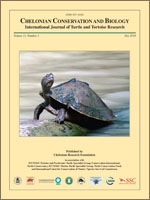Gathering natural history information on a species is a necessary first step in understanding its ecology, which can lead to hypothesis generation and the data necessary for its conservation. I studied desert box turtles (Terrapene ornata luteola) at the Sevilleta National Wildlife Refuge in central New Mexico at the northern periphery of this subspecies in the Chihuahuan Desert. I recorded locations and marked all box turtles found in the northeastern part of the refuge over 23 yrs during trips to the site in 1986–1989, 1998, and 2008. I found that desert box turtles at the site sometimes were active in May and early June, but were most active in late June or early July into early October, with greatest activity in July and August. Numbers of box turtles on roads were significantly correlated with air temperature but not precipitation. Daily activity was bimodal during peak activity months. Growth was fairly rapid until about 10 yrs of age and then leveled off dramatically. The largest adults were about 125–130 mm carapace length (CL), and females were significantly longer than males in 2 of 3 survey periods. By 2008, I found a number of adults that were 30–40 yrs old, and several might have been older than 40 yrs. The mean number of eggs in a clutch varied from 2.67 to 3.55, there was no indication of multiple clutches being produced, and variation in egg number was only weakly explained by the CL of the female. Despite low reproductive rates, the population on the Sevilleta has persisted and likely will do well into the future in this protected reserve.
How to translate text using browser tools
1 July 2014
Activity, Growth, Reproduction, and Population Structure of Desert Box Turtles (Terrapene ornata luteola) at the Northern Edge of the Chihuahuan Desert
David J. Germano
ACCESS THE FULL ARTICLE

Chelonian Conservation and Biology
Vol. 13 • No. 1
July 2014
Vol. 13 • No. 1
July 2014
age structure
box turtles
longevity
Reptilia
size structure
Testudines
thermobiology




